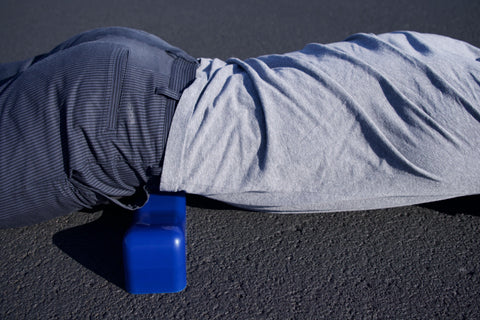Introducing the TWO hip flexor muscles that cause a host of low back and hip pain: Iliacus and Psoas. Both muscles lie on the front of the body and tighten after long periods of sitting in chairs.
Iliacus Hip Flexor Release
Iliacus tends to tighten after long periods of sitting. If you are a desk jockey or sit down for 8+ hours a day, release the Iliacus.

Iliacus Placement (above)
Psoas Hip Flexor Release
Psoas tightness goes hand in hand with Iliacus tightness. Massage the Psoas as well as the Iliacus if you sit for 8+ hours a day to loosen up those poor hip flexors.

Psoas Placement (above)
Targets: Rectus Femoris, Iliacus (Psoas instruction coming soon!)
Check out anatomical considerations here: Hip Flexor Muscles
Rectus Femoris & Iliacus Hip Flexor Release - Written Instructions

Rectus Femoris Placement: When standing, lift one leg in a marching motion. With your hand, feel the muscle engaged just below the crease of the hip - that is the Rectus Femoris. Remember this muscle. Lay face-down on the floor, and place the trigger on this hip flexor muscle.
Iliacus Placement: Using your fingers, locate the large, bony hip bone protrusion on the front of your body. Feel for the muscle 1-2 inches inside the hip bone, 0-2 inches above the waistline. When you locate the Iliacus, it will feel good to massage. Check out the Iliacus picture above if you get lost.
Level 1: Prone

Take a load off, try this one out. Roll the trigger-side foot back and forth slowly for an active massage. *Pictured on the Rectus Femoris*
Level 2 (not pictured): Lay your chest on the ground. Dorsally flex the trigger-side ankle so the foot is normal to the floor. Lock out the trigger-side leg so the knee is off the ground.
Level 3: The Windshield Wiper

The most motion of any QL Claw move - buckle up. Move the trigger-side foot back and forth in a windshield wiper like motion. Feel free to get creative with the motion - move the foot around however feels right.
Level 4: The Stinger

Proceed with caution: user may elicit loud dad grunts and hard exhales. Engage the trigger side glute, lifting the knee off the ground.
How to know you've released a trigger point: When you release a knot/trigger point, you will feel the muscle give and will simultaneously feel the device sink in to your body. A massage generally feels less painful under higher pressure once a trigger point is released.
Hip Flexor Release FAQ:
How To Release Hip Flexor Trigger Point
Place the QL Claw tool on the hip flexor muscle of choice, slow the breath, and allow your hip flexor muscle to sink into the tool. Take deep belly breaths and use light movement for 60-120 seconds to slowly release trigger points.
How To Release A Tight Hip Flexor
Combine massage to the Iliacus and Psoas muscles, and stretching exercises to release a tight hip flexor.
Where To Massage To Release Hip Flexor Pain
Massage the Psoas and Iliacus muscles to release lower back hip flexor pain, the TFL to release outer hip pain, and Rectus Femoris to release mid-thigh pain.
Sources/Influences:
[1] Donnelly, Joseph M. Travell, Simons & Simons Myofascial Pain and Dysfunction: the Trigger Point Manual. 3rd ed., Wolters Kluwer Health, 2019.
[2] Davies, Clair, and Amber Davies. The Trigger Point Therapy Workbook: Your Self-Treatment Guide for Pain Relief. 3rd ed., New Harbinger Publications, Inc., 2013.


